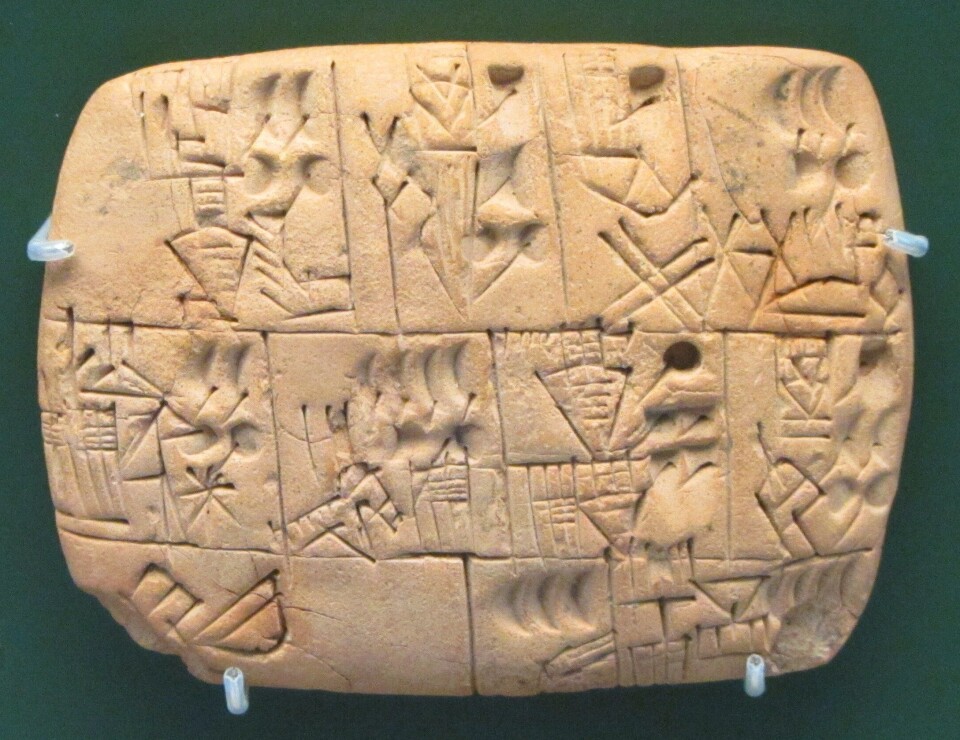
What exactly are interest rates and where do they come from?
The sting from increased interest rates is something people have felt as early as ancient Mesopotamia.
“Interest is the rental price for borrowing money — or goods and resources,” says Lars Fredrik Øksendal, an economic historian at the Inland Norway University of Applied Sciences.
Interest rates have been with us for a very long time, he told sciencenorway.no.
“If you go far back in history, interest is about renting seed,” he said.

In ancient Mesopotamia —today's Iraq — archaeologists have uncovered clay tablet after clay tablet that address business operations. ‘Amil-mirra must pay 330 units of barley grain to the tablet's owner at harvest,’ reads a typical 3,000-year-old inscription.
“If you lend seed to someone, you expect to get something more in return, a rental price for the seed you have made available. It’s compensation for giving up something for a period of time,” he said.
Expectations of getting something back
Historians think the fact that animal herds grew as the animals reproduced may be one of the explanations for interest rates. In the same way, seeds naturally multiply over time. So it’s perhaps not surprising that people expected something more in return than just what they lent out.
Since most of the earliest clay tablets that have been found concern transactions and business activities, it’s reasonable to assume that people have liked doing business for a long time. And the invention of interest was a fundamental part of the development of advanced societies and economies.
“Interest is in many ways the prerequisite for commercial lending. If a person couldn’t make money by ‘lending money’ — if in fact it was an actual loan — we can assume that far fewer people would have engaged in this practice,” says Ola Innset.
Innset is an economic historian at BI School of Business, and says that large-scale interest rates and loans are a relatively new phenomenon, despite their ancient precursors.
“Right up until the late Middle Ages, interest, and making money from money, was both controversial and also often forbidden,” he said.

Religious taboo
At times, several major religions considered lending money and charging interest taboo. In the Middle Ages, the Catholic Church considered charging other Christians interest to be a sin. A separate term emerged for demanding unreasonably high interest rates — usury.
In Norway, until recently, there was a ‘usury ban’, but this was lifted when a new criminal law was introduced in 2002, because the politicians who passed the law believed that the prohibition against charging unreasonably high interest was sufficiently covered in a section of the Price Ceiling Act.
“Taking out loans in the Middle Ages was largely connected with necessity, such as after a crop had failed, and it was often considered morally wrong to make money from such a situation,” Innset said.
The religious taboo against charging interest lives on today more strongly in the Muslim world, where several Muslim countries have developed separate forms of banking that do not rely on interest.
“But the rise of capitalism gave people a completely different view of credit and consequently of interest as something productive that can lead to growth,” Innset said.
Modern economies and interest
Interest made it far easier to move large amounts of money from the rich to others who wanted to invest, but did not have enough money themselves. It was a good investment to allow others to invest— and some of the profit came as interest. Win-win.
Daring investors and explorers served as a driving force during colonial times. In Amsterdam, Lisbon or Seville, groups of merchants scraped together financing and sent ships to sea towards Indonesia. If the ships came back loaded with spices, everyone involved would have earned enough money for the rest of their life. This way of doing business was also central to the industrial revolution.
“But investments do not necessarily have to come from private capital. With the rise of democracy, states had the economic and organizational muscle to lend money themselves, and to regulate commercial lenders,” Innset said.
Enter central banks
“Central banks were eventually established to bring more order to the money system itself. These banks became tools for government policy in the 20th century. Since central banks issue currency, that gives states power over the money,” Innset said.
Central banks – Norges Bank in the case of Norway – determine the general level of interest rates in the economy. They do this by setting a ‘key interest rate’ that all commercial banks must use.
“Since we, unlike the farmers of the Middle Ages, now live in societies steeped in debt, the interest rate is very important,” he said.
If the interest rate is high, people buy less — fewer people take out loans for cars and housing, and more people leave their money in the bank. This reaction is used to ‘cool down’ the economy.
Growth and reconstruction
After the Second World War, Norwegian public banks such as Husbanken, the Norwegian State Housing Bank, and Lånekassen, the Norwegian State Educational Loan Fund, were established to lend people money at low interest for specific purposes. In addition, there was a clear "low interest rate policy" to encourage growth and contribute to reconstruction.
In the 1970s and 1980s, interest rate setting and central banks were made more independent of politicians — meaning politicians had less power over money.
Back at the Inland Norway University of Applied Sciences, Øksendal explains that today's interest rate policy is somewhat special.
“The interest rates we are experiencing now are not historically very high, but they are problematic because there has been an enormous build-up of debt during the low-interest period,” Øksendal said.
Since the financial crisis in 2008, and especially during the coronavirus pandemic era, there has been more money in circulation. This happened because the central bank gave private banks increased credit on their loans.
This makes it easier for banks to lend more money when times are tough for people and companies. Then there is the danger that a country’s currency will become less valuable due to inflation, although inflation has long remained low due to globalization and China's cheap production.
But if a lot of money has been printed, it will eventually have an impact on the economy. Right now, this policy has resulted in inflation in stock markets and house prices. So there is a lot of debt out there.
“That is the big problem,” says Øksendal.
Translated by Nancy Bazilchuk
———
Read the Norwegian version of this article at forskning.no
------



































